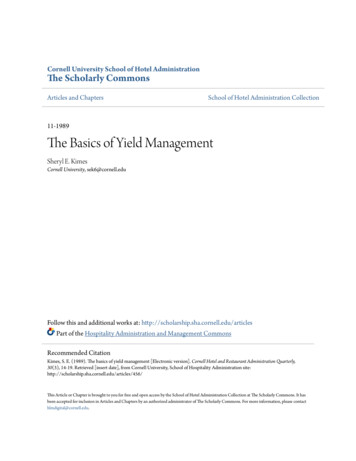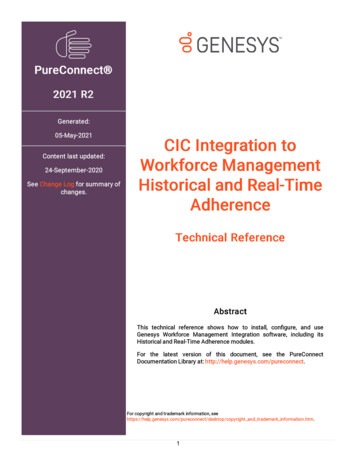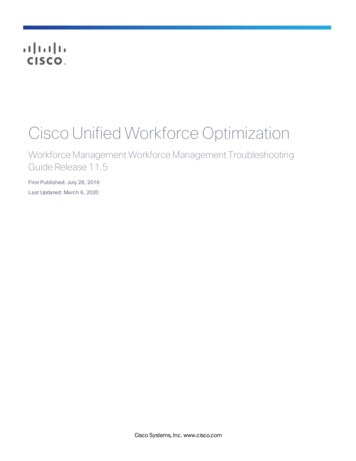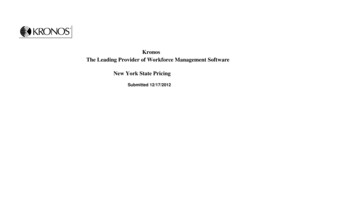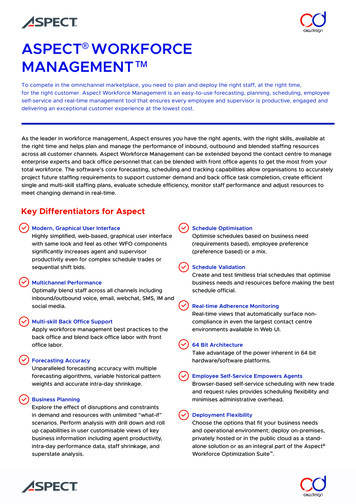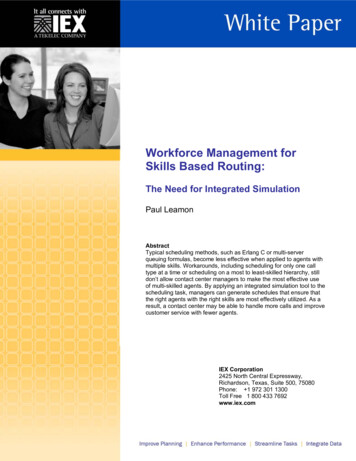
Transcription
Workforce Management forSkills Based Routing:The Need for Integrated SimulationPaul LeamonAbstractTypical scheduling methods, such as Erlang C or multi-serverqueuing formulas, become less effective when applied to agents withmultiple skills. Workarounds, including scheduling for only one calltype at a time or scheduling on a most to least-skilled hierarchy, stilldon’t allow contact center managers to make the most effective useof multi-skilled agents. By applying an integrated simulation tool to thescheduling task, managers can generate schedules that ensure thatthe right agents with the right skills are most effectively utilized. As aresult, a contact center may be able to handle more calls and improvecustomer service with fewer agents.IEX Corporation2425 North Central Expressway,Richardson, Texas, Suite 500, 75080Phone: 1 972 301 1300Toll Free 1 800 433 7692www.iex.com
Workforce Management for Skills-Based Routing: The Need for Integrated SimulationIntroductionSkills-based routing allows contact centers to route different types of calls — for example sales,service, and payment processing — to the agents who have the skill necessary for that call. Whenagents are cross-trained, so that some or all have more than one skill, skills-based routing canincrease the amount of time agents spend productively by handling calls, offering significant costsavings and improved service levels without additional staff.Implementing skills-based routing adds new workforce management challenges for contact centers.The process of creating accurate forecasts and developing efficient schedules for agents in contactcenters that handle only one call type is well understood; achieving the same goals when the contactcenter handles different types of calls is much more complex. In order to realize the full benefits ofskills-based routing, it becomes more critical to create accurate agent requirement forecasts, andagent schedules that maximize the potential efficiency of multiskilled agents. Poor quality in forecastsor schedules can completely undermine the value of skills-based routing, and even decreaseperformance.Workforce management systems employ several different approaches to forecasting and schedulingto address the unique complexities of skills-based routing. Many of these approaches have proveninadequate because they fail to account for the complexity in call distribution between cross-trainedagents. A true skills-based routing approach must consider the actual logic of the ACD routing rulesand efficiencies from multiskilled agents using an integrated simulator to return accurate forecasts,and efficient schedules.Forecasting Using Erlang CIn a contact center that is not using skills-based call routing, agent requirements can be derivedthrough simple mathematic calculations. Forecasts of call volume and average handling time over thedesired time intervals and service level goals can be input into an industry-standard Erlang C formulathat calculates the number of agents needed for each time interval.However, using a mathematical formula by itself to calculate agent requirements does not yieldaccurate or optimal results in skills-based routing environments. Mathematical formulas like Erlang Calways result in overstaffing when applied in skills-based routing environments, because they do notaccount for sophisticated ACD call routing logic and efficiencies from multiskilled agents. Whenagents have multiple skills, there is a greater likelihood that an agent with the necessary skill for anincoming call will be available, so fewer agents overall are required to manage the same number ofcalls at the same service level.Erlang C assumes each agent handles a single call type on a first-come, first-served basis. Thisassumption is not valid for skills-based call routing because some, or all, agents will have more thanone skill and can handle multiple call types. Call types may also have different priorities, allowingPlatinum-level customers to reach an agent before Gold-level customers, so all calls may not beoffered to agents on a first-come, first-served basis.Most importantly, in a skills-based routing environment, agent availability depends on other agents’skills and schedules. Since agents scheduled for one particular call type may also be utilized for othercall types, the number of agents needed for one call type depends on which agents are scheduled forevery other call type. Further, determining the percentage of time an agent will spend handle a certaincall type in a skills-based routing environment depends on dynamic call routing rules such asCopyright 2004 IEX CorporationAll rights reserved. IEX and TotalVieware registered trademarks of IEX corporation.1
Workforce Management for Skills-Based Routing: The Need for Integrated Simulationconditional queuing, changing call priority, queuing to backup skills, time of day, and day of week —and cannot be calculated with simple mathematic formulas.Creating effective schedules in skills-based call routing environments is a circular problem that cannot be solved by mathematics alone: the exact number of agents required can only be determinedafter schedules are created; and, before schedules can be created, it is necessary to know how manyagents are required to be scheduled.In spite of these issues, some workforce management systems still use Erlang C alone to calculateagent requirements for skills-based call routing. Agent requirements for each call type are calculatedindependently, then an arbitrary efficiency factor is applied to lower the requirements to estimate thegreater efficiency provided by multiskilled agents. A variation on this approach adds the call volume ofall call types and calculates the weighted AHT for each interval. But, in this combined workloadvariation, the results of the Erlang C calculation are based on the assumption that all agents are fullycrossed-trained in all skills. Using this approach, the number of agents must therefore be increasedby an arbitrary factor to account for the fact that not all agents are fully cross-trained. A combinedworkload also means that calculations are based on one service level for all call types, which is oftennot realistic or appropriate.Forecasts that rely solely on Erlang C in skills-based routing environments are inherently inaccurate.While it might be possible to manually adjust forecasts up or down to improve the estimate inenvironments with only two or three skills, the adjustment becomes much less accurate as thenumber of skills increases. Further, even with adjustments, these calculations will not account for theimpact of dynamic ACD call routing and the interplay of individual agent skills and availability overeach interval.Forecasting Using Multi-Server QueuingAnother mathematical forecasting method uses multi-server queuing formulas to calculate agentrequirements. This approach assumes agents within agent groups possess identical skills, andprovides an approximation of the multiskill efficiency gained by skills-based call routing. Multiserverqueuing formulas cannot be used to forecast agent requirements when agents are assigned toindividual skills and skill levels, however. The formulas assume that calls are routed to separatequeues for each agent group or to a common queue for all agent groups.The assumptions in multi-server queuing formulas are rarely true in the real world. In most skillsbased routing environments, calls may be queued to agent groups simultaneously or based onconditional rules. Agents are also typically assigned different skill priority levels, which further affectcall routing.Multi-server queuing formulas have another significant weakness, since agent requirements arecalculated for skill sets rather than call types. For example, if a contact center handles calls in Englishand Spanish, agents are assigned associated English, Spanish or Bilingual skills. The formulascalculate requirements for English agents, Spanish agents and Bilingual agents, instead of just therequirements needed for English calls and Spanish calls. This approach does not allow the workforcemanagement system to determine the best set of schedules that use the best mix of English-,Spanish- and Bilingual-skilled agents.Copyright 2004 IEX CorporationAll rights reserved. IEX and TotalVieware registered trademarks of IEX corporation.2
Workforce Management for Skills-Based Routing: The Need for Integrated SimulationYet another difficulty is determining how many total agents are needed for the English and Spanishcalls, since the percentage of time each Bilingual agent will spend handling English and Spanish callsis not known.Skill Scheduling for a Single Call Type at a TimeOnce a forecast has been generated, the workforce management system must schedule agents tomeet the forecasted agent requirements. Creating schedules in skills-based routing centers issignificantly more complex than non-skills centers, because the workforce management system nolonger is just scheduling enough total agents to meet requirements for one call type, but mustschedule the right combination of agents to meet requirements for each call type, and still takecontact center work rules into account.The most simplistic scheduling approach assigns multiskilled agents to one call type for eachscheduling interval. For example, agents with Sales and Service skills might be scheduled for Salescalls from 8:00 am to noon and Service calls from 1:00 pm to 5:00 pm. Scheduling agents to specificcall types for each interval results in low quality schedules because the schedules either sacrifice theefficiencies of skills-based routing or do not match the actual ACD routing rules.“Locking” an agent into a specific call type or skill during the scheduled period entirely defeats theskills-based routing efficiency gains possible with multiskilled agents, since an agent assigned to onecall type will not receive other call types, even if that agent is available and has the required skill.If the agent is not "locked" into a specific skill during the interval, the schedule assignments becomemeaningless because calls will be routed according to ACD rules. An agent with multiple skills willreceive both Sales and Service call types throughout the day, even though the schedule shows thatthe agent will receive only Sales calls in the morning, and only Service calls in the afternoon.Schedule from Most- to Least-Skilled AgentsAnother method schedules the agents with the most skills first. This approach makes the assumptionthat skills are related and that an agent with Skill 3 can also handle call types based on Skill 2 andSkill 1: First, the system schedules the most skilled agents (agents with Skills 1, 2 and 3) against thecall type forecast requirements that use Skill 3. Next, requirements of call types that use Skill 2 are added to those that use Skill 3, thesystem applies a factor to decrease the combined requirements, and schedules agents withSkills 1 and 2. Finally, the requirements of call types that use Skill 1 are added to those that use Skills 2 and3, and the system again decreases the combined requirements and schedules agents withSkill 1.This approach cannot be used when agents have individual, non-related skills — such as language—and are not uniformly trained to be in one of a few different skill sets. In most contact centers withskills-based routing, a skill is not related or dependent on another skill and may be assigned to agentsbased not only on training but also on actual performance.Copyright 2004 IEX CorporationAll rights reserved. IEX and TotalVieware registered trademarks of IEX corporation.3
Workforce Management for Skills-Based Routing: The Need for Integrated SimulationMost importantly, the method of scheduling from most-skilled to least-skilled agents does not considerrouting rules that affect agent availability such as conditional queuing or queuing to backup skills. Inother words, the approach assumes that an agent with a skill is always available to handle theassociated calls. Most ACD rules enable greater control of call distribution than that to ensure thatcertain agents receive calls they are skilled for only when other conditions are met. For example, aBilingual-skilled agent might only receive English calls if there are other Spanish skilled agentsavailable.Forecasting and Scheduling Through Integrated SimulationThe key flaw with the forecasting and scheduling methods described previously is that they do nottake the actual contact center’s ACD routing rules into account. They also do not resolve the circularchallenge of forecasting and scheduling: forecasted agent requirements are dependent on individualagent skills and agent schedules, which in turn are dependent on forecasted requirements and theway that calls will actually be routed.The solution to achieve both accurate forecasts and efficient agent schedules is to integratesimulation of ACD routing into the forecasting and scheduling process.With an integrated simulator, agent requirements are calculated by call type, including the economiesof scale gained by multiskilled agents, and agent availability by call type is also calculated. Schedulescan be automatically generated against the agent requirements, and then analyzed after simulatingACD call routing — including network call routing for multisite centers.Forecasts and schedules can then automatically be adjusted to improve results, and the process canautomatically repeat until the best set of schedules and an accurate forecast have been determined.The resulting output of this solution is: Agent requirements that account for economies of scale gained by using multiskilled agentsNumber of agents available by call typeSchedules refined to meet contact center goals for service level and efficient use of agentsThis solution accommodates the many variables and the complexity associated with a multiskillenvironment and automatically creates accurate forecasts and effective working schedules.Secondarily, integrated simulation can evaluate the impact of changes to forecast call volumes andhandling times, call routing rules, agent skills, schedules, service levels and other variables so thatperformance can continue to be managed after the initial forecasting and scheduling cycle.A simplified depiction of the process follows:Copyright 2004 IEX CorporationAll rights reserved. IEX and TotalVieware registered trademarks of IEX corporation.4
Workforce Management for Skills-Based Routing: The Need for Integrated Simulation.Integrated Multiskill SimulationTo achieve these results, the simulator must be capable of duplicating the complexity of the actualACD routing in the contact center, including network routing in multisite centers. Routing may bebased on any number of factors, including hold times, agent availability, time-of-day, and agent skilllevels. If the simulator offers "canned" rule types that cannot duplicate actual ACD routing, theaccuracy of the forecasts and quality of the resulting schedules will be low.The simulator must also be fully integrated into the workforce management forecasting andscheduling cycle so that the iterative process of forecasting, scheduling and adjustments areautomated. This process must be repeated multiple times to deliver high-quality forecasts andschedules. If the simulator is not integrated, the manual process of running simulations againstschedules and adjusting the schedules and forecasts is prohibitively time-consuming and introducesopportunities for error.ConclusionAccuracy is the key to successfully forecasting and scheduling for skills-based call routing.Accurate forecasting and scheduling is needed in order to consistently meet and exceed service levelgoals without significantly overstaffing. Without accurate scheduling for skills-based routing, contactcenters will fail to achieve the benefits of skills-based routing, consistently missing service level goalsbecause of understaffing or exceeding labor costs due to overstaffing.Copyright 2004 IEX CorporationAll rights reserved. IEX and TotalVieware registered trademarks of IEX corporation.5
Workforce Management for Skills-Based Routing: The Need for Integrated SimulationThe workforce management system used in a contact center with skills-based routing must be able toaccurately forecast agent requirements and schedule agents for maximum efficiency. These resultsrequire that the center’s ACD routing rules be taken into account through an integrated simulator thatcan automatically optimize new forecasts and schedules, and can provide an accurate evaluation ofthe impact of changes.About the AuthorPaul Leamon is the Director of TotalView Marketing and is responsible for marketing of theTotalView Workforce Management product. Previously, he was manager of systems engineeringand guided the TotalView product design at IEX for eight years. His experience includes extensivework with customers to ensure that each TotalView feature provides the business solutions to meetthe customer’s needs. Leamon holds a patent for Skills-Based Scheduling for Telephone Call Centersand has several other workforce management patents pending. He earned his bachelor’s degree inelectrical engineering, specializing in computer engineering, from the University of Texas at Austin.About IEXIEX, a Tekelec company, is a leading provider of innovative productivity solutions to contact centers.TotalView Workforce Management solutions significantly reduce operating costs while enablingsuperior service. More than 2,500 centers with more than 630,000 agents worldwide work with IEX toimprove planning, enhance performance, streamline tasks and integrate data. More information canbe found at http://www.iex.com.Copyright 2004 IEX CorporationAll rights reserved. IEX and TotalVieware registered trademarks of IEX corporation.6
Workforce Management for Skills-Based Routing: The Need for Integrated Simulation Most importantly, the method of scheduling from most-skilled to least-skilled agents does not consider routing rules that affect agent availability


